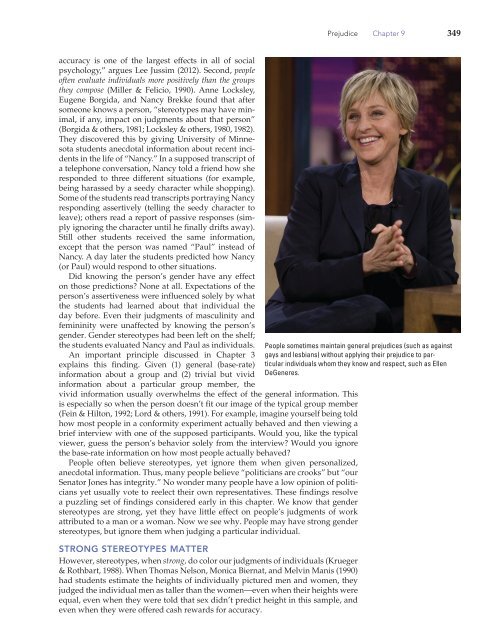Chapter 9: Prejudice: Disliking Others (2947.0K) - Bad Request
Chapter 9: Prejudice: Disliking Others (2947.0K) - Bad Request
Chapter 9: Prejudice: Disliking Others (2947.0K) - Bad Request
You also want an ePaper? Increase the reach of your titles
YUMPU automatically turns print PDFs into web optimized ePapers that Google loves.
accuracy is one of the largest effects in all of social<br />
psychology,” argues Lee Jussim (2012). Second, people<br />
often evaluate individuals more positively than the groups<br />
they compose (Miller & Felicio, 1990). Anne Locksley,<br />
Eugene Borgida, and Nancy Brekke found that after<br />
someone knows a person, “stereotypes may have minimal,<br />
if any, impact on judgments about that person”<br />
(Borgida & others, 1981; Locksley & others, 1980, 1982).<br />
They discovered this by giving University of Minnesota<br />
students anecdotal information about recent incidents<br />
in the life of “Nancy.” In a supposed transcript of<br />
a telephone conversation, Nancy told a friend how she<br />
responded to three different situations (for example,<br />
being harassed by a seedy character while shopping).<br />
Some of the students read transcripts portraying Nancy<br />
responding assertively (telling the seedy character to<br />
leave); others read a report of passive responses (simply<br />
ignoring the character until he finally drifts away).<br />
Still other students received the same information,<br />
except that the person was named “Paul” instead of<br />
Nancy. A day later the students predicted how Nancy<br />
(or Paul) would respond to other situations.<br />
Did knowing the person’s gender have any effect<br />
on those predictions? None at all. Expectations of the<br />
person’s assertiveness were influenced solely by what<br />
the students had learned about that individual the<br />
day before. Even their judgments of masculinity and<br />
femininity were unaffected by knowing the person’s<br />
gender. Gender stereotypes had been left on the shelf;<br />
the students evaluated Nancy and Paul as individuals.<br />
An important principle discussed in <strong>Chapter</strong> 3<br />
explains this finding. Given (1) general (base-rate)<br />
information about a group and (2) trivial but vivid<br />
information about a particular group member, the<br />
<strong>Prejudice</strong> <strong>Chapter</strong> 9 349<br />
People sometimes maintain general prejudices (such as against<br />
gays and lesbians) without applying their prejudice to particular<br />
individuals whom they know and respect, such as Ellen<br />
DeGeneres.<br />
vivid information usually overwhelms the effect of the general information. This<br />
is especially so when the person doesn’t fit our image of the typical group member<br />
(Fein & Hilton, 1992; Lord & others, 1991). For example, imagine yourself being told<br />
how most people in a conformity experiment actually behaved and then viewing a<br />
brief interview with one of the supposed participants. Would you, like the typical<br />
viewer, guess the person’s behavior solely from the interview? Would you ignore<br />
the base-rate information on how most people actually behaved?<br />
People often believe stereotypes, yet ignore them when given personalized,<br />
anecdotal information. Thus, many people believe “politicians are crooks” but “our<br />
Senator Jones has integrity.” No wonder many people have a low opinion of politicians<br />
yet usually vote to reelect their own representatives. These findings resolve<br />
a puzzling set of findings considered early in this chapter. We know that gender<br />
stereotypes are strong, yet they have little effect on people’s judgments of work<br />
attributed to a man or a woman. Now we see why. People may have strong gender<br />
stereotypes, but ignore them when judging a particular individual.<br />
STRONG STEREOTYPES MATTER<br />
However, stereotypes, when strong, do color our judgments of individuals (Krueger<br />
& Rothbart, 1988). When Thomas Nelson, Monica Biernat, and Melvin Manis (1990)<br />
had students estimate the heights of individually pictured men and women, they<br />
judged the individual men as taller than the women—even when their heights were<br />
equal, even when they were told that sex didn’t predict height in this sample, and<br />
even when they were offered cash rewards for accuracy.

















